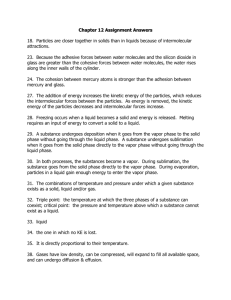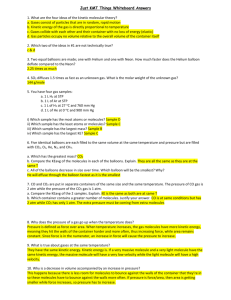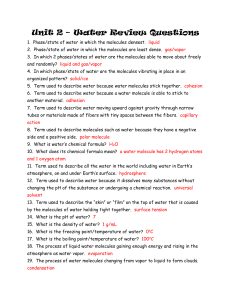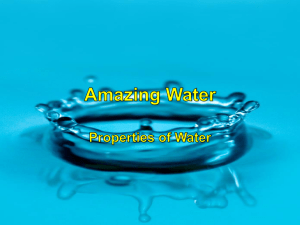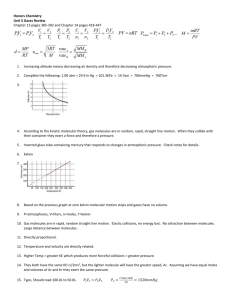Unit 6: States of Matter Honors Chemistry
advertisement
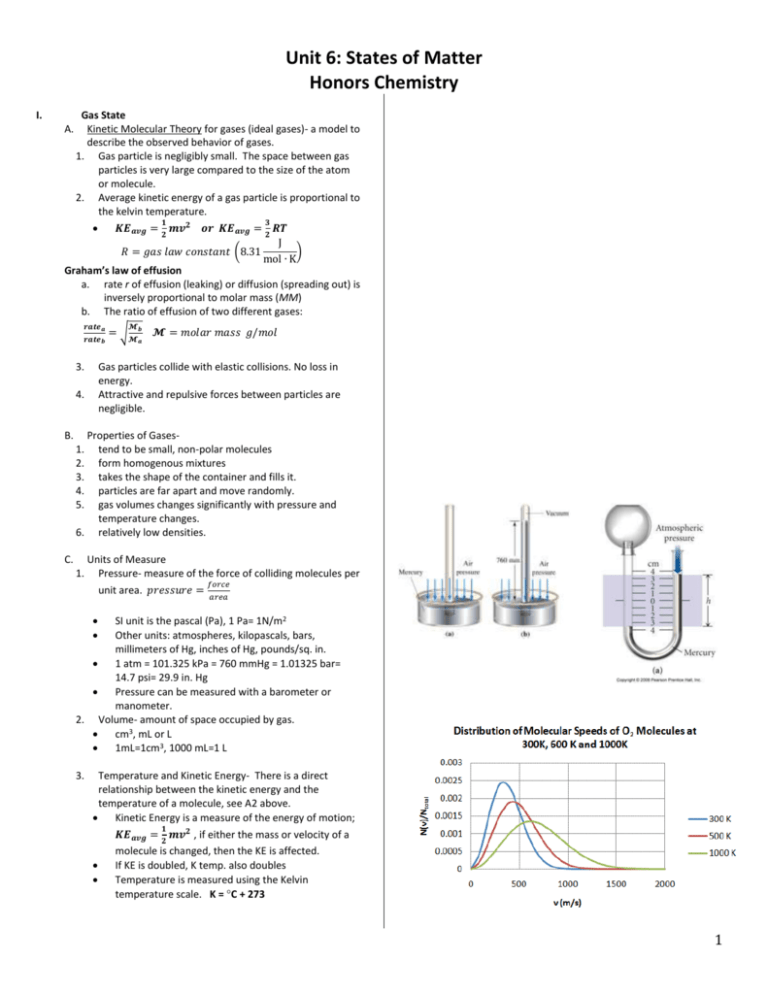
Unit 6: States of Matter Honors Chemistry I. Gas State Kinetic Molecular Theory for gases (ideal gases)- a model to describe the observed behavior of gases. 1. Gas particle is negligibly small. The space between gas particles is very large compared to the size of the atom or molecule. 2. Average kinetic energy of a gas particle is proportional to the kelvin temperature. 𝟏 𝟑 𝑲𝑬𝒂𝒗𝒈 = 𝒎𝒗𝟐 𝒐𝒓 𝑲𝑬𝒂𝒗𝒈 = 𝑹𝑻 𝟐 𝟐 J 𝑅 = 𝑔𝑎𝑠 𝑙𝑎𝑤 𝑐𝑜𝑛𝑠𝑡𝑎𝑛𝑡 (8.31 ) mol ∙ K Graham’s law of effusion a. rate r of effusion (leaking) or diffusion (spreading out) is inversely proportional to molar mass (MM) b. The ratio of effusion of two different gases: A. 𝒓𝒂𝒕𝒆𝒂 𝒓𝒂𝒕𝒆𝒃 3. 𝓜𝒃 𝓜𝒂 𝓜 = 𝑚𝑜𝑙𝑎𝑟 𝑚𝑎𝑠𝑠 𝑔/𝑚𝑜𝑙 Gas particles collide with elastic collisions. No loss in energy. Attractive and repulsive forces between particles are negligible. 4. B. =√ Properties of Gasestend to be small, non-polar molecules form homogenous mixtures takes the shape of the container and fills it. particles are far apart and move randomly. gas volumes changes significantly with pressure and temperature changes. 6. relatively low densities. 1. 2. 3. 4. 5. C. 1. Units of Measure Pressure- measure of the force of colliding molecules per 𝑓𝑜𝑟𝑐𝑒 unit area. 𝑝𝑟𝑒𝑠𝑠𝑢𝑟𝑒 = 𝑎𝑟𝑒𝑎 SI unit is the pascal (Pa), 1 Pa= 1N/m2 Other units: atmospheres, kilopascals, bars, millimeters of Hg, inches of Hg, pounds/sq. in. 1 atm = 101.325 kPa = 760 mmHg = 1.01325 bar= 14.7 psi= 29.9 in. Hg Pressure can be measured with a barometer or manometer. 2. Volume- amount of space occupied by gas. cm3, mL or L 1mL=1cm3, 1000 mL=1 L 3. Temperature and Kinetic Energy- There is a direct relationship between the kinetic energy and the temperature of a molecule, see A2 above. Kinetic Energy is a measure of the energy of motion; 𝟏 𝑲𝑬𝒂𝒗𝒈 = 𝒎𝒗𝟐 , if either the mass or velocity of a 𝟐 molecule is changed, then the KE is affected. If KE is doubled, K temp. also doubles Temperature is measured using the Kelvin temperature scale. K = C + 273 1 4. D. 1. Amount of gas- moles are used, symbol is “n” One mole of any gas at Standard Temperature and Pressure, STP (273 K and 1 atm) will occupy 22.4 L. This is called the molar volume of a gas. Gas Laws 1 Boyles Law- 𝑉 ∝ T and n constant 𝑃 𝑃1 𝑉1 = 𝑃2 𝑉2 Charles Law- 𝑉 ∝ 𝑇 2. 𝑉1 𝑃1 𝑇1 𝑇2 = 𝑃2 𝑇2 Avogadros’s Law- 𝑉 ∝ 𝑛 T and P constant 5. = Gay-Lussac’s law- 𝑃 ∝ 𝑇 V and n constant 3. 4. 𝑇1 P and n constant 𝑉2 𝑉1 𝑛1 = 𝑉2 𝑛2 Ideal Gas Law- One equation that combines the other gas laws to describe the behavior of an ideal gas. 𝑷𝑽 = 𝒏𝑹𝑻 R= ideal gas constant (if P is atm, V is liters, T is kelvin) 0.0821 6. 𝑎𝑡𝑚∙𝐿 𝑚𝑜𝑙𝑒∙𝐾 Rearrangement of the Ideal Gas Lawa. 𝑷𝟏 𝑽 𝟏 combined gas law 𝒏𝟏 𝑻𝟏 = 𝑷𝟐 𝑽 𝟐 𝒏𝟐 𝑻𝟐 b. 7. density of a gas is proportional to it molar mass and inversely proportional to temperature. 𝒎 𝑷∙𝓜 =𝒅= 𝑽 𝑹∙𝑻 Dalton’s Law of partial pressures- total pressure of a mixture of gases is the sum of the partial pressures of the individual gases. 𝑃𝑡𝑜𝑡𝑎𝑙 = 𝑃1 + 𝑃2 + 𝑃3 = 𝑛𝑎 𝑅𝑇 𝑉 + 𝑛𝑏 𝑅𝑇 𝑉 + 𝑛𝑐 = (𝑛𝑎 + 𝑛𝑏 + 𝑛𝑐 ) II. A. B. C. = (𝑛𝑡𝑜𝑡𝑎𝑙 ) 𝑃𝑎 = 𝑋𝑎 ∙ 𝑃𝑡𝑜𝑡𝑎𝑙 (𝑚𝑜𝑙𝑒 𝑓𝑟𝑎𝑐𝑡𝑖𝑜𝑛) 𝑅𝑇 𝑅𝑇 𝑅𝑇 𝑉 +. . . 𝑉 𝑉 𝑋𝑎 = 𝑛𝑎 𝑛𝑡𝑜𝑡𝑎𝑙 Liquid State- (11.1-11.6) General Properties1. takes the shape of it’s container 2. does not expand to fill container 3. incompressible 4. flows Comparison of Properties- all three states of matter are dependent upon a balance between two factors: 1. The Kinetic Energies of the particles, (Temperature). increase KE particles separate 2. The Energies of attraction between the particles, (Intermolecular Forces). Increase IMF and particles are more strongly attracted Intermolecular Forces - properties of liquids; vapor pressure, boiling point are dependent upon the force of attraction between the particles. 1. London Dispersion Forces (just dispersion)instantaneous dipole created by the random motion of electrons throughout the molecule. a. found in all molecules b. strength dependent upon: polarizability of molecule. molar mass of molecule 2 2. 3. 4. D. Select Properties- based on IMF’s 1. Surface Tension- tendency of liquids to minimize their surface area. interior molecules attract with six “neighbors”, surface molecules attract to only four. surface tension decreases as IMF’s decrease. 2. Viscosity- resistance of a liquid to flow. Greater the IMF’s, higher the viscosity 3. Capillary Action- ability of liquids to flow against gravity up a narrow tube. Balance between cohesive and adhesive forces. cohesive – attraction of liquid molecules to each other. adhesive- attraction for liquid molecules and surface of tube. 4. Vapor Pressure- In a closed container at constant temperature vaporization and condensation are at equilibrium: rates are equal 𝑔𝑎𝑠 ⟷ 𝑙𝑖𝑞𝑢𝑖𝑑 a. Pressure exerted by the gas at equilibrium is called vapor pressure( Pvap.) b. Effect of temperature- at increased temperatures higher proportion of molecules have sufficient KE to escape liquid state; therefore: ℎ𝑖𝑔ℎ𝑒𝑟 𝑇 ⇒ ℎ𝑖𝑔ℎ𝑒𝑟 𝑃 c. At a given T all molecules have same KEave, therefore molecules with weaker intermolecular forces are held less tightly at surface; therefore: 𝑤𝑒𝑎𝑘𝑒𝑟 𝐼𝑀 𝑓𝑜𝑟𝑐𝑒𝑠 ⇒ ℎ𝑖𝑔ℎ𝑒𝑟 𝑃𝑣𝑎𝑝 d. high Pvap indicates volatility—tendency to evaporate. 5. III. B. shape Dipole-Dipole Forces- attraction between oppositely charged ends of polar molecules. Ion-Dipole Forces- attraction between an ion and a polar molecule. Hydrogen Bonding- especially strong type of dipoledipole. Only for hydrogen atoms bonded to O, F or N of one molecule and O, F and N of another molecule. Boiling Point- Temperature at which the vapor pressure of a liquid equals the external pressure, acting on the surface of the liquid. a. At this temperature, the KE of the molecules in the interior of the liquid are sufficient to break their IMF’s and enter the gas phase. b. Stronger the IMF ⟹lower the vapor pressure⟹ higher the boiling point. c. Normal Boiling Point- boiling point at 1 atm. Phase Changes Heating curve- graph of the temperature of the system versus the amount of heat added or removed. a. Kinetic energy- absorbed (KE increasing/endothermic) or released (KE decreasing/exothermic) : 𝑞 = 𝑚 ∙ 𝐶𝑝 ∙ ∆𝑇 𝑚 = 𝑚𝑎𝑠𝑠 𝑖𝑛 𝑔𝑟𝑎𝑚𝑠 ∆𝑇 = 𝑇𝑓 − 𝑇𝑖 𝐶𝑝 = 𝑠𝑝𝑒𝑐𝑖𝑓𝑖𝑐 ℎ𝑒𝑎𝑡 𝑐𝑎𝑝𝑎𝑐𝑖𝑡𝑦 𝑜𝑓 𝑚𝑜𝑙𝑒𝑐𝑢𝑙𝑒 𝐽 𝐻2 𝑂 𝑠𝑜𝑙𝑖𝑑 = 2.09 𝐻2 𝑂 𝑙𝑖𝑞𝑢𝑖𝑑 = 4.18 𝐻2 𝑂 𝑔𝑎𝑠 = 2.01 𝑔∙°𝐶 𝐽 𝑔∙°𝐶 𝐽 𝑔∙°𝐶 3 b. C. Phase change- bond breaking=endothermic, bond formation= exothermic 𝑣𝑎𝑝𝑜𝑟𝑖𝑧𝑎𝑡𝑖𝑜𝑛, 𝑙𝑖𝑞𝑢𝑖𝑑 𝑡𝑜 𝑔𝑎𝑠 ∆𝐻𝑣𝑎𝑝 = 40.7𝑘𝐽/𝑚𝑜𝑙 𝑐𝑜𝑛𝑑𝑒𝑛𝑠𝑎𝑡𝑖𝑜𝑛, 𝑔𝑎𝑠 𝑡𝑜 𝑙𝑖𝑞𝑢𝑖𝑑 ∆𝐻𝑐𝑜𝑛𝑑 = −40.7 𝑘𝐽/𝑚𝑜𝑙 𝑓𝑢𝑠𝑖𝑜𝑛, 𝑠𝑜𝑙𝑖𝑑 𝑡𝑜 𝑙𝑖𝑞𝑢𝑖𝑑 ∆𝐻𝑓𝑢𝑠𝑖𝑜𝑛 = 6.01 𝑘𝐽/𝑚𝑜𝑙 𝑠𝑜𝑙𝑖𝑑𝑖𝑓𝑖𝑐𝑎𝑡𝑖𝑜𝑛, 𝑙𝑖𝑞𝑢𝑖𝑑 𝑡𝑜 𝑠𝑜𝑙𝑖𝑑 ∆𝐻𝑠𝑜𝑙𝑖𝑑 = −6.01 𝑘𝐽/𝑚𝑜𝑙 sublimation, solid to gas Phase Diagram-pressure and temperature relationship. 1. point A: triple point (three phases at equilibrium) above triple point: melting and vaporization below triple point: sublimation (deposition) 2. line A-C: equilibrium vapor pressure curve for liquid (nbp: normal boiling point occurs at 1 atm pressure) 3. C: critical point, where there is no distinction between liquid and vapor (no liquid-vapor surface) 4. line A-D: equilibrium vapor-pressure curve for solid (sp: sublimation point depends on pressure) 5. line A-B: melting point of solid at various pressures (mp: normal melting point occurs at 1 atm) a. negative slope when liquid is the densest phase (melting point decrease with pressure) b. positive slope (more common) when solid is the densest phase (melting point increases with pressure) 4 5 6
